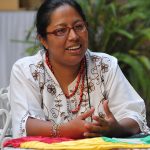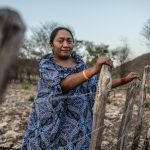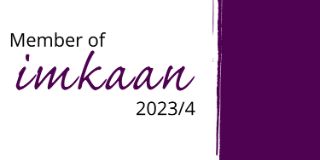Yásnaya Aguilar Gil is a Mixe linguist from Ayutla, Oaxaca, Mexico. In most of her writings and public dialogues, she asks: what is being a woman? What is being a feminist? Above all, what is being an indigenous woman? In this process of reflection, she dialogues with other women such as the Kaqchikel writer (Guatemala) Aura Cumes, and the K’iche ’political scientist Gladys Tzul (Guatemala), and Yásnaya* says:
“I understand “indigenous” as a word that names nations, people and communities that suffered colonization processes and also in the processes of formation of modern national states, indigenous nations were by force within those legal entities; these states have fought their existence and are related to them through oppression. Indigenous peoples are nations without a state.
Now I understand that the word “indigenous” is a political category, not a cultural or racial category (although it is racialized). In addition, I understood that it was not enough to deny and stop using the word “indigenous” for the category to stop operating on me. I realised that it is possible to use it as a political tool to subvert the structures that sustain them with the ever-present risk of falling into the rivers of folkloristic and essentialisation.”
This reflection by Yásnaya allows us to think about the presence and resistance that women and their communities have been doing since colonization times in what we now call Latin America and the Caribbean. This totalizing concept to which native/indigenous nations have not been referred since their worldviews, languages, and territorial experiences. For example, the peoples of the Andes coined the concept Abya Yala to refer to the American continent from their political position. In the field of critical thinking, Abya Yala is an ethical attitude that recognises the right of the various indigenous peoples to live to exist and preserve their history, their territory, and their sacred places.
As Latin American women part of the migrant community in the United Kingdom, knowing the presence and resistance of women from the territories where we were born is important to reinforce our roots, show international solidarity, and as far as possible, support the campaignings that Indigenous women lead, and, when possible, support their causes with donations.
In the context of the International Day of Indigenous Women, we want to recognise the role of leadership and resistance that women have been playing in Latin America.
Here are 10 indigenous women resisting in Latin America:
-
Maria do Socorro Silva, Brazilian Amazonian Enviromentalist

She is a quilombola, but she is also indigenous. Her home is in Bacarena, Pará very close to Tocantins River, the central fluvial artery of the country. The Tocantins is one of the largest clearwater rivers in South America. For 10 years, she has been fighting on multiple fronts against all the extractives projects in her territory. She says that her struggle is about land, race, inequality, and justice.
She is president of the Association of Caboclos, Indigenas, and Quilombolas da Amazônia (Cainquiama), which represents thousands of local forest-dwellers; she arranged protests and filed two lawsuits against Hydro Alunorte. She denounced the company to public prosecutors, the Pará state legislative assembly, and the media.
-
Helena Gualinga, youth kichwa sarayaku environmentalist champion

She is part of the Sarayaku indigenous community, located deep in the Ecuadorian Amazon. Living between Finland and Ecuador, Gualinga is worried that extractive industries would destroy her motherland. The Sarayaku community is one of over 800 indigenous communities in Latin America. The extractive industries have been able to exploit the territory for oil exploration since 1996 when the Ecuadorian government signed a contract with national oil company Petroecuador and CGC, a subsidiary of Chevron in Argentina.
About her activism, Helena says: “the year I was born, an oil company entered without my community’s consent. Therefore, when I was growing up, I constantly saw all the things that happened to my people, to the people that said no. It was always part of my life that people were fighting for our communities”. Through her activism, she wants to challenge the stereotypes that people have of indigenous people, they can be very damaging to our communities and to our cultures, to our ways of being and living. For that reason, people need to keep that in mind that those thoughts and those ideas actually do harm to people.
-
Bertha Zúñiga Caceres, human rights defender and daughter of Berta Caceres

She is the general coordinator of the Civic Council of Popular and Indigenous Organizations of Honduras (COPINH) and daughter of Berta Caceres, who was murdered in March 2016 because of her struggle to prevent dam building on the River Gualcarque in the Lenca people’s territory.
At the age of 29, Bertha Zúñiga suspended her university studies and focused on finding the truth behind the murder of her mother. Although she has experienced intimidation, she said: “I think that the main point is the need to dignify ourselves as a people. So many people have been murdered in this country (Honduras) and there is so much daily violence that we experience that, I believe, we are a country that deserves justice and we have to fight to live differently. We dream in the tranquillity that everyone wants, with justice and truth as flags of struggle”.
-
Ericka Guadalupe Vásquez Flores, Mayan K’iche’ translator for migrants

A Mayan K’iche’ originally from Aldea Chuatroj in the municipality and department of Totonicapán in Guatemala. She is a sociolinguist by profession and teacher of the K’iche’ language. She shares the importance of promoting mother tongues from her own experiences and knowledge. She is one of the translators that spent hours making long-distance phone calls from her home in Guatemala translating to Spanish for migrants in Immigration and Customs Enforcement detention centers in the USA who only spoke their indigenous language (especially during Trump’s administration).
She is among a growing group of mostly Guatemalan women who translate for detained indigenous-speaking migrants. For her, the mother tongue K’iche’, is so important to continue in the next generations. She says about her own work: “I am a digital activist in Mayan Languages, I am starting a project to teach the Language from social networks, and very soon a YouTube channel, taking advantage of the technological resource that we already have at our disposal. I am also a volunteer promoter of the Liberation for the Migrant project. Our job is to help people in detention centers in the USA interpret the K’iche’ language into Spanish and vice versa, due to not being able to communicate in Spanish with the lawyers.”
-
Yásnaya Elena Aguilar Gil is an Ayuujk linguist (mixe)

She has contributed to various projects on the dissemination of linguistic diversity, the development of grammatical content for educational materials in indigenous languages , and projects of documentation and attention to languages at risk of disappearance. She has collaborated by writing in Spanish, her second language, in magazines, with some texts translated into English.
In 2019, in the Camara de Diputados en Mexico, she gave a speech in her mother tongue, Mixe, and since then she has gone to various places and given conferences and written books about languages, identity and community resistance: Un Estado sin nosotrxs (2018 OnA Editions), and Ää: Manifestos sobre la diversidad lingüística (2020, Editorial Almadía). According to her resistance and her activism for the right to have clean water in her community, Yásnaya expresses: “The group of women in the community to which I belong, what they ask above all is water. Moreover, some feminists have said that this is not a feminist cause. That is why it is important to have discussions more from respect and not from a colonialist vision. There is a colonialist vision that the struggle is always that of the West.”
-
María Lorena Ramírez, Tarahumara runner

Originally from the Sierra Tarahumara, Chihuahua, Maria Lorena Ramirez is a Mexican athlete who speaks Tarahumara. Like many women from indigenous communities, as she did not have access to formal education, his brother Mario serves as a translator to Spanish, when she is interviewed or is outside her community.
“I like being a Rrámuri woman, I like having this culture, these lands that I am treading on, where I have grown up, it is a very beautiful place. We have everything, we have trees, we have many things here in the state of Chihuahua. I feel very happy with what I have”, she says.
She is known for their long-distance running talents. Traditionally, her indigenous people have used running as transportation and communication between distant settlements. Decades ago, physiological tests found that when the Tarahumara run long distances, their blood pressure actually falls and their heart rate remains at a steady 130 beats per minute — all while motoring for mile after 8-minute mile. They call themselves Rarámuri, which some ethnographers translate as “those who run fast” and others as “the lightning-footed people.” In the past, they practiced persistent hunting, which means they ran the game to death.
To Lorena, running is a normal activity that brings her joy. In 2017, she beat 500 athletes from 12 different countries to come first in the 50-kilometer ultramarathon known locally as the UltraTrail Cerro Rojo, held in the state of Puebla, Mexico.
-
Lorena Cabnal, Maya Ketchʼi y Xʼinka feminista comunitaria y sanadora ancestral

She is a healer, feminist, and defender of the territory originally from the X’inka-Maya people of Guatemala. She lived through childhood and teenage time in a domestic violence environment, in the midst of the Guatemalan civil war, that cost the lives of thousands of people. At age of 15, she fled her home, and at 25, after having studied Medicine and Psychology at the university, she decided to follow the example of her maternal grandmother X’inka as an ancestral healer. About her communitarian feminist approach, she says: “Defence of the land-body territory is a process of healing emotional and spiritual. This is part of a recovery of women because from our bodies is where the oppression of the patriarchal system, colonialism, racism have been built but also the body is where the vital energy of emancipation, of rebellion, of transgression, of resistance, of eroticism as vital energy lies”.
You can read her book by clicking here.
-
Noelia Naporichi, young Qom member of Parlamento de Mujeres Indigenas in Argentina
 She was born in Santa Fe, Rosario Argentina. She is a member of the Qom Nation within the Argentine territory. She has been active in the field of indigenous rights since she was 16 years old. Currently, she is part of the Indigenous Women for Good Living group, which includes 36 Latin American nations. For this women’s movement, it is important that women take leadership in their territories doing work in community kitchens, and having positions of political representation.
She was born in Santa Fe, Rosario Argentina. She is a member of the Qom Nation within the Argentine territory. She has been active in the field of indigenous rights since she was 16 years old. Currently, she is part of the Indigenous Women for Good Living group, which includes 36 Latin American nations. For this women’s movement, it is important that women take leadership in their territories doing work in community kitchens, and having positions of political representation.
Noelia forged a large part of her militancy in the neighborhood where one of the Qom communities lives in the Barrio Toba Municipal, Rouillón and Maradona, in the southwestern area of Rosario. In times of the COVID-19, Noelia founded a Community Center for Good Living in her mother’s house to give support for the most vulnerable people around her place. As well, she participated in the historic march on May 25, 2021, where indigenous women walked more than 1,500 kilometers from different parts of the country to demand that the State incorporate the term “terricide” to condemn those responsible for “crimes against nature and against humanity”.
-
Jakeline Romero, a Wayúu human rights defender

She is a Wayúu human rights defender in the department of La Guajira, in northeastern Colombia. She is part of the Sütsuin Jieyuu Wayúu organisation (Fuerza de Mujeres Wayuu), created in 2006 with the aim of making visible and denouncing the violations of the rights of the indigenous Wayúu. This situation is a result of mining megaprojects, forced displacement, the situation of vulnerability of the victims of the armed conflict and the presence of armed groups, and the militarization of the territory of La Guajira.
Her leadership has focused on the complaints about the licenses that the national government has given to the mining company Carbones El Cerrejón, which currently seeks to divert one of the most important sources of water for the population, the Bruno stream. Paramilitary groups have been persecuting her since 2005. In 2012, the paramilitaries directly threatened Jazmín Romero Epiayu, Jackeline’s sister and a leader of the Wayúu community. Later in 2014, her youngest daughter, Génesis Gutiérrez, was the victim of intimidation. However, although the facts have been disclosed to the authorities, those responsible for these threats remain unknown.
-
Samantha Siagama, an Embera transgender indigenous woman

She had to exile herself from her Embera motherland to save her life. Like a transgender woman, she left her family, and on her way to self-determination, she found a place in the coffee zone in Santuario, where she has a job and a home. When she knew about cases of other trans women who were in situations like her, she spoke with her boss and asked to give them work in coffee plantations. Samantha has managed to be the supervisor of the coffee zone where she lives and opens Santuario as a home for other indigenous trans women who are fleeing from territorial violence and on their bodies.
About her struggle, she says: “When you want to be transgender, they (the families) don’t like it. ‘If he’s doing that, it’s better to kill’, they said. So that people do not murmur about a father or a brother. They prefer to kill the trans person. The other option is that your own family send you with the guerrillas… However, not even the guerrillas, who were always eager to recruit new combatants, wanted to have transgender people in their ranks. Much less, transgender indigenous people”.
Samantha and other trans women from Santuario are fighting to have access to identity through their ID with their new name and life, in order to get out of marginalization and find better living conditions.
* Yásnaya Elena A. Gil. “La sangre, la lengua y el apellido. Mujeres indígenas y estados nacionales.” Available in Spanish here.





